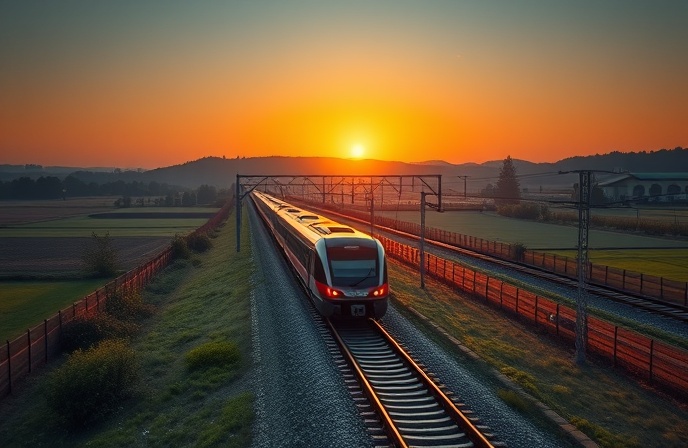India’s Hyperloop Leap: ICF Chennai’s Crucial Role

India’s Leap into Hyperloop Technology: The Role of ICF Chennai
This article explores the significant contribution of the Integral Coach Factory (ICF) in Chennai to India’s burgeoning Hyperloop technology. The Indian Railways’ ambitious foray into this high-speed transportation system marks a pivotal moment in the nation’s infrastructural development. The selection of ICF, renowned for its expertise in high-speed rail manufacturing, as the key electronics developer for the Hyperloop project, underscores the synergy between existing railway capabilities and the demands of this innovative technology. This collaboration leverages the ICF’s proven track record in developing complex electronic systems for projects like the Vande Bharat Express, demonstrating a strategic transfer of knowledge and expertise to a cutting-edge transportation solution. We will examine the specific role of ICF, the technological challenges involved, the implications for India’s transportation future, and the broader context of this development within the global Hyperloop landscape. The integration of indigenous technology and the collaborative efforts between the ICF, the Indian Railways, and IIT Madras will be highlighted as crucial factors in the project’s success.
ICF’s Expertise and its Application to Hyperloop
The Integral Coach Factory (ICF) in Chennai, a leading manufacturer of railway coaches in India, brings a wealth of experience to the Hyperloop project. Its proven capabilities in designing and manufacturing sophisticated electronic systems for high-speed trains like the Vande Bharat (a semi-high-speed train) are directly transferable to the complex electronic requirements of a Hyperloop system. This expertise includes the development of onboard control systems, power management units, communication networks, and safety systems, all critical components for the safe and efficient operation of a Hyperloop. The seamless integration of these electronic systems is crucial for achieving the high speeds and reliability expected from Hyperloop transportation.
Technological Challenges and Solutions
Developing electronic components for Hyperloop presents unique technological challenges. The extreme speeds involved require robust and highly reliable electronic systems capable of withstanding intense vibrations and electromagnetic interference (EMI). Precise control systems are crucial for maintaining safe and efficient operation, requiring advanced algorithms and high-speed data processing capabilities. The ICF’s experience in addressing similar challenges faced in high-speed rail technology provides a strong foundation for overcoming these hurdles. Furthermore, the successful integration of these systems with the Hyperloop’s propulsion and levitation systems will be a key factor in determining the overall success of the project.
The 410-meter Test Facility at IIT Madras
The 410-meter Hyperloop test tube at IIT Madras (Indian Institute of Technology Madras) is a crucial element in the development and testing process. This facility, reportedly the longest in Asia, provides a platform for validating the performance of the various components, including the electronics developed by ICF. The testing environment allows engineers to assess the functionality of the systems under realistic conditions, identifying and addressing potential issues before deployment in a full-scale system. The use of indigenous technologies in the construction and operation of this facility underscores India’s commitment to developing a self-reliant Hyperloop ecosystem.
Strategic Implications and Future Outlook
India’s investment in Hyperloop technology represents a bold step toward modernizing its transportation infrastructure and enhancing its global competitiveness. The successful development and deployment of Hyperloop could significantly reduce travel times between major cities, boosting economic activity and improving connectivity. The ICF’s role in this endeavor is pivotal, not only for its technological contribution but also for its implications for the Indian railway industry’s growth and diversification into cutting-edge transportation technologies. The project also showcases India’s capabilities in developing and deploying advanced technologies, fostering innovation and attracting investment in the field. Furthermore, the successful integration of indigenous technology in this project signifies a significant leap towards self-reliance in a sector previously dominated by foreign players. The experience gained through this project could propel India to the forefront of Hyperloop development globally.
Conclusions
The collaboration between the Integral Coach Factory (ICF), Indian Railways, and IIT Madras represents a significant milestone in India’s pursuit of Hyperloop technology. ICF’s expertise in high-speed rail electronics, honed through projects like the Vande Bharat Express, is directly applicable to the challenges of Hyperloop development. The 410-meter test track at IIT Madras provides a crucial platform for validating the technology under realistic conditions. The successful development and implementation of this technology will drastically improve connectivity, bolster economic growth and position India as a pioneer in this transformative transportation sector. The project’s emphasis on indigenous technology development further highlights India’s commitment to self-reliance and innovation. The long-term implications extend beyond transportation, impacting related industries and fostering technological advancement within the nation. While challenges remain, the progress made thus far indicates a promising future for Hyperloop technology in India and highlights the pivotal role played by the ICF in realizing this ambitious goal. The successful completion of this project will not only transform India’s transportation landscape but also establish the nation as a global leader in Hyperloop technology, attracting further investment and showcasing its engineering prowess on a world stage. The project stands as a testament to the potential of strategic collaboration between government, academia, and industry, proving that ambitious technological advancements are achievable through concerted effort and innovation.


